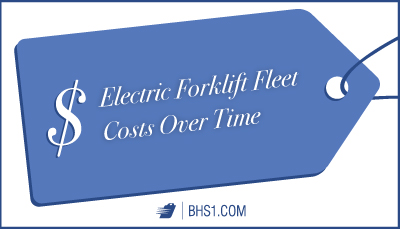We use cookies to make your experience better. To comply with the new e-Privacy directive, we need to ask for your consent to set the cookies. Learn more.
Electric Forklift Fleet Costs Over Time
If this is the year you switch to an electric forklift fleet, costs are bound to be a major topic of conversation in your office. The expense of a capital investment like a forklift fleet can't be limited to the purchase price alone, of course. You need to consider the future costs, as well, and those can be hard to foresee.
When you're planning an investment in electric forklifts, then, be sure to include the following factors into your calculation to ensure the best return on investment throughout the entire working life of your trucks:
- The sticker price of each lift truck.
- Forklift battery purchases and associated infrastructure.

- Lift truck operator salaries.
- Forklift battery purchases and associated infrastructure.
This is where you might start, but it's far from the whole picture. In fact, trade journal Inbound Logistics once reported that the purchase price of a lift truck only represents 20 percent of the total cost over the equipment's entire life-span.
Keep that figure in mind when you're choosing your forklifts. It's usually wise to pay a little more at the outset if that initial investment will lead to greater efficiency or reduced maintenance on a shift-by-shift basis.
Depending on your charging strategy, you might need more or fewer forklift batteries, so you need to start with the plan: Will you install park and charge systems, or create an optimized battery room that can change batteries quickly enough to handle demand? You may need fewer batteries with the former option, but you'll also end up replacing them more often, and you could run into trouble when it's time for battery maintenance if you don't invest in solid battery handling equipment.
No matter which strategy you choose, you can reduce overall costs and rightsize your battery fleet by including a battery fleet management system with your initial investment. Read more about how fleet management improves battery-use efficiency in our in-depth coverage here.
Be sure to factor the salaries you pay your lift truck operators into the total cost of equipment. After all, forklifts don't create value unless someone sits behind the wheel. As of the latest figures from the Bureau of Labor Statistics, "material moving machine operators," which includes forklift staff, made a median pay of $16.29 per hour, or $33,890 per year. Add to that costs of benefits and related human resources outlays, and you'll begin to see why the purchase price of a forklift only adds up to 20 percent of the total cost.
Don't make the mistake of factoring in projected maintenance costs for lift trucks, while forgetting to plan for upkeep on chargers, battery handling equipment, and forklift batteries themselves.
All of these factors must go into the lifetime cost of an electric forklift. But they don't have to be overwhelming. Try a maintenance contract with your dealer, or invest in your own high-quality battery handling, washing, and watering equipment to extend the lifespan of your power source, driving a greater ROI during the entire span of ownership. And don't forget that battery fleet management software, which will provide the data you need to keep maintenance costs low.
Reducing Electric Forklift Fleet Costs by Protecting Batteries
Think of forklift batteries as the "fuel" for your fleet. You'll save money every shift that your batteries are operating at their peak performance. That's why an investment in battery maintenance is one of the best ways you can keep overall costs down on the fleet itself. With a great plan for battery handling, electric forklift fleet costs won't take up too much of the budget, leaving more room for reinvestments in future business growth.
References:
"Material Moving Machine Operators." BLS. U.S. Bureau of Labor Statistics, 24 Oct. 2017. Web. 20 Nov. 2017.
Ruriani, Deborah. "Optimizing Your Forklift Fleet." InboundLogistics. Thomas Publishing Company, Oct. 2006. Web. 20 Nov. 2017.
